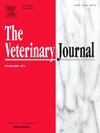测量小牛血液中免疫球蛋白浓度的径向免疫扩散试验和一种新型侧流装置试验的比较。
IF 3.1
2区 农林科学
Q1 VETERINARY SCIENCES
引用次数: 0
摘要
以低血清IgG浓度(< 10g/L)为特征的乳牛被动免疫转移(FTPI)失败,与高犊牛发病率和死亡率以及晚年较差的生产和生殖结果相关。犊牛可在24小时至7天之间采血检测FTPI。使用径向免疫扩散(RID)参考试验直接测量犊牛血清中的IgG耗时、昂贵且需要实验室设置。最近,一种名为“ImmunIGY”的新型“笔侧”测试被引入英国市场,该测试使用基于免疫层色谱的侧流装置(LFD)“直接测量小牛全血中的IgG”。当前研究的目的是比较RID和“免疫”测量。采用Pearson相关、McNemar卡方、Bland-Altman图、passingbablok回归和受试者工作特征(ROC)曲线对测量结果进行比较。Pearson相关性较低(r=0.35)。McNemar卡方统计显示,两种检测在IgG切点10g/L (0.25 (p= 0.61))和15g/L IgG (0.15 (p= 0.69))上均无统计学差异。Passing-Bablok回归的截距值为10.76 (95%CI=-1.10 ~ 20.19),说明两种方法之间的系统差值无显著性差异,斜率值为0.81 (95%CI= 0.53 ~ 1.09),因此斜率= 1的假设不被拒绝。Bland-Altman图显示广泛的一致性限为-29.99至24.04g/L,平均差为-2.98g/L (SD=13.51, 95%CI -5.31- -0.65),具有恒定误差的证据。ROC曲线显示10g/L和15g/L切点曲线下面积分别为0.73和0.68。总体而言,“ImmunIGY”试验的特异性优于敏感性试验,后者在实践中导致假阳性试验的数量较少,但假阴性试验的数量相对较高,这表明它适合用作筛查工具,而不是用于单个动物诊断。本文章由计算机程序翻译,如有差异,请以英文原文为准。
Comparison of the radial immunodiffusion test and a novel lateral flow device test for measuring immunoglobulin concentrations in calf blood
Failure of transfer of passive immunity (FTPI), characterized by low serum IgG concentrations (< 10 g/L) in dairy calves, is associated with high calfhood morbidity and mortality, as well as poor productive and reproductive outcomes in later life. Calves can be blood sampled to test for FTPI between 24 h and 7 days of life. Direct measurement of IgG in calf serum using the radial immunodiffusion (RID) reference test is time-consuming, costly and requires a laboratory setting. Recently a new ‘pen-side’ test called ‘ImmunIGY’ was brought to the UK market to ‘directly measure IgG in calf whole blood’ using an immunochromatography-based lateral flow device (LFD). The objective of the current study was to compare RID and ‘ImmunIGY’ measurements. Measurements were compared using Pearson correlation, McNemar chi-squared, Bland-Altman plots, Passing-Bablok regression and receiver operating characteristics (ROC) curves. Pearson correlation was low (r = 0.35). McNemar chi-squared statistics revealed no statistically significant differences between the two tests at both IgG cut points of 10 g/L (0.25 (p = 0.61)) and 15 g/L IgG (0.15 (p = 0.69). The Passing-Bablok regression intercept value was 10.76 (95 %CI=-1.10–20.19) showing that the systematic difference between the methods was not significantly different from zero and the slope value was 0.81 (95 %CI = 0.53–1.09) so the hypothesis that the slope is equal to 1 was not rejected.
Bland-Altman plots showed wide limits of agreement −29.99–24.04 g/L, with a mean difference of −2.98 g/L (SD=13.51, 95 %CI −5.31- −0.65), with evidence of constant error. ROC curves showed area under the curve for both 10 g/L and 15 g/L cut points of 0.73 and 0.68 respectively. Overall, the test specificity of the ‘ImmunIGY’ test was superior to the sensitivity of the test which would in practice lead to a low number of false positive tests, but a relatively high number of false negatives, suggesting its appropriate use as a screening tool rather than for individual animal diagnostics.
求助全文
通过发布文献求助,成功后即可免费获取论文全文。
去求助
来源期刊

Veterinary journal
农林科学-兽医学
CiteScore
4.10
自引率
4.50%
发文量
79
审稿时长
40 days
期刊介绍:
The Veterinary Journal (established 1875) publishes worldwide contributions on all aspects of veterinary science and its related subjects. It provides regular book reviews and a short communications section. The journal regularly commissions topical reviews and commentaries on features of major importance. Research areas include infectious diseases, applied biochemistry, parasitology, endocrinology, microbiology, immunology, pathology, pharmacology, physiology, molecular biology, immunogenetics, surgery, ophthalmology, dermatology and oncology.
 求助内容:
求助内容: 应助结果提醒方式:
应助结果提醒方式:


